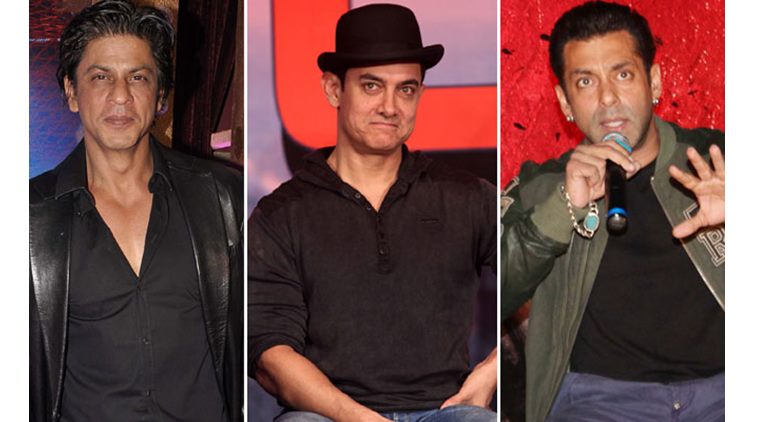Opinion Khan do — until when?
Aamir, Salman and Shah Rukh have powered Bollywood for two decades. But their popularity is now conditional

 The holy trinity of the three Khans — Aamir-Salman-Shah Rukh — soared to the top in the late 80s-early 90s and never abdicated that spot, regardless of hits and flops.
The holy trinity of the three Khans — Aamir-Salman-Shah Rukh — soared to the top in the late 80s-early 90s and never abdicated that spot, regardless of hits and flops.
“Indian cinema, meanwhile, is the most active on earth — in great part because the country has a population that still needs the communal movie experience we have lost.” This sentence, written in 2008 by well-known film critic and historian, David Thompson, is appropriately sweeping — and in part, both true and fallacious. It puts a faintly patronising distance between the “we” in the West who have “lost the communal movie experience” and “they” who still, in 2017, need it.
Yes, “we” in India do need a “communal movie experience”. But it isn’t as if “they” in the West, and all those other parts of the globe which ravenously consume Western imports, do not. What else is a thousand-seater multiplex in the US and China, ringing to the rafters with Rogue One, the latest in the Star Wars space saga, a film expressly meant to milk a profitable franchise one more time?
And yet, there is a difference. The numbers in India are formidable. Our movie-goers constitute an entire world in and of themselves and there are enough films, filmmakers and stars of our own that provide us this experience. We do not need to borrow from the West. Our popular film stars create that community whose strength and stickiness is unique — that stardom is the glue that keeps the biggest film industry in the world intact, Bolly-knock-on-wood. And that is the reason our biggest stars have such a long shelflife; they have that ineffable, magical something that keeps us in perpetual thrall.
Recently, at work, I was asked, “Have you seen Shah Rukh Khan’s latest photo-shoot?” I had to confess I hadn’t. Two colleagues, both young women, sighed and said, “He looks soooo sexy.” Another chimed in with, “No, no, he looks very haggard, unlike Salman and Aamir who have such shiny faces.” A fourth said, “I don’t care — I’m still a fan.” And we launched into an animated conversation about these stars who have ruled Bollywood for over 20 years.
Two decades. And counting. That’s two generations (and because this is India, the one before and after, which makes an astounding four) which still go to the movies together. This is the community which has faithfully cleaved to what I call “The Khandom”.
The holy trinity of the three Khans — Aamir-Salman-Shah Rukh — soared to the top in the late 80s-early 90s and never abdicated that spot, regardless of hits and flops. Regardless of how Akshay Kumar’s films make as much money, if not more, than theirs. Regardless of how much mud is slung at them by the burgeoning army of bigots, because there is no other word for the culturally impoverished ignoramuses who air their religious prejudices in such a fashion.
The Incredibly Durable Khans, a phrase I’ve used in my book 50 Films That Changed Bollywood, represent the Bollywood film-and-fan, a construct ever changeable, yet ever constant. They speak to us, we speak to them. In this respect, they are like the indestructible stars down the ages; in the 1950s, there was Raj Kapoor-Dev Anand-Dilip Kumar. In the 60s, Shammi Kapoor, Shashi Kapoor, Dharmendra — and that toothy, smiley, crinkly-eyed wonder, Rajesh Khanna. In the 70s, there was the one and only Amitabh Bachchan, who towered over that decade and most of the next.
It took till the end of the 80s, and the advent of a brand new generation, to change the game. Aamir Khan sang presciently, “Papa kehte hain bada naam karega”, in Qayamat Se Qayamat Tak in 1988; look at him today, in early 2017 — a soaring star with his latest super-hit Dangal, which has him playing middle-aged and grizzled, giving way to younger actors. That’s a naam to reckon with.
As is Salman Khan, who bared his chest and declared, via a pliant pigeon, to his simpering lady love in 1989, “Maine pyar kiya”. The nation fell in love with this familiar, yet new variant of young love and established Salman, who was very far from being the bashful-bad-boy he has turned into now, as a top-flight star. With his massive 2016 hit, Sultan, in which he submitted to a plot and a middle-age spread, even if briefly, Salman became the king of Bollywood. Till Aamir’s Dangal, which has reportedly already shot past the 300-crore mark .
Shah Rukh Khan entered the film industry just a tad after these two, but he owned the 90s from when he bore his dulhaniya away in Dilwale Dulhaniya Le Jayenge (1995). He was the first Bollywood actor to conquer the NRI diaspora completely. Compared to Salman and Aamir, SRK hasn’t really had a great 2016. His Fan didn’t endear him to his fans and he played second fiddle to a young female lead in Dear Zindagi — but his hold over the industry is as strong as ever.
But there’s also a clear message viewers have handed out to these three stars, who are the most powerful producers in Bollywood too. They cannot take their astonishing longevity for granted any more. The time when you could just show up and be loved is over; conditions now apply.
These three came along just when the nation was feeling its liberalised bones, when to be young was a confused and confusing thing, when rebellion was no longer the only way to romance. In the last quarter-century, India has become a different country. Our narratives have shifted from the naïve to the knowing. From the restrictions of the license raj to the freedom of plastic, back to the shackles of no money in the banks. From a nation which looked down upon the rich to an aspiring workforce, where English is the lingua franca, even in films made in Hindi.
This is the nation, in a constant state of tumult and contrarian pushes and pulls, for which these Khans have to stay relevant. Can they stay the course?



